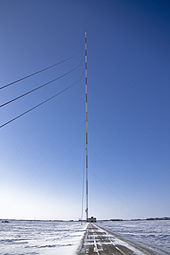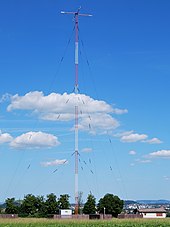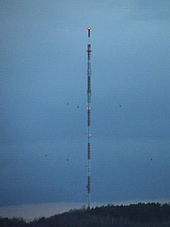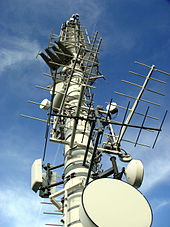Transmission mast




A transmission tower is usually a to backstays guyed structure made of steel framework or steel tube with a constant height over the entire cross-section (see also the mast ). It is used to accommodate antennas for transmission purposes, or for direct use as a transmission antenna in the form of a mast antenna or a self-radiating transmission mast .
development
Transmission masts are erected as an alternative to free-standing transmission towers made of steel or concrete . In the early days of broadcasting, transmission masts were used almost exclusively as carriers for transmission antennas. The history of large transmitter masts also reflects the development of communication technology over the decades: while long, medium and shortwave operation in the longwave range, which was heavily used until the 1980s, required large antenna systems, today wireless communication takes place in this area 4 m from. For digital radio data transmission, the use of some of the existing tall structures is sufficient and traditional transmission masts are hardly ever erected.
Constructive properties
However, transmission masts are still cheaper to erect than transmission towers. In the wind, they usually sway more than free-standing structures of the same height. Because of the guy foundations, they require more space than free-standing constructions.
One problem with transmitter masts is the risk of wind-induced vibrations. This is very large, especially with tubular steel masts. The tendency to vibrate can be reduced by installing cylindrical vibration dampers in the construction. Such vibration dampers, which look like cylindrical bulges, can be found, for example, on the transmission masts of DHO38 in Saterland (Lower Saxony, Germany).
Constructions are also erected that consist of a free-standing tower (usually made of reinforced concrete), on the top of which a transmission mast is fixed to the ground. The best known such construction is the Gerbrandytoren in Lopik (Netherlands). Other towers of this construction are u. a. near Smilde (Netherlands) and until 2009 in Waldenburg (Baden-Württemberg, Germany) .
As a self-radiating transmission mast , they are usually superior to an isolated tower from a high-frequency point of view, as they have a lower base point capacitance and a constant cross-section that can be selected thinner than with a free-standing construction, which results in better radiation properties. However, there can be problems with parasitic currents that flow off via the guys, which is why they have to be divided with isolators in most cases or have to be grounded at the base via a choke coil (or a trap circuit ) . In the case of guys divided by insulators, there can be problems with static charges during thunderstorms. Surge arresters are also necessary in parallel to the insulators, which require regular maintenance, which is associated with high costs due to their difficult accessibility.
Coils and capacitors of the resonance transformer and lightning protection devices are often housed in a separate tuning house. This stands either directly next to the transmission mast or, in some constructions, also acts as a base for the transmission mast.
A fixed ladder must always be provided in order to allow access to components of the transmission mast that require certain maintenance, such as flight safety lights, transmission antennas, devices or guy guying. This can be attached inside or outside the construction. In the case of tubular steel masts, this is usually attached inside for weather protection reasons. In some transmission masts for shrinkage-reducing transmission antennas with multiple feeds, the vertical ladder is isolated from the mast construction in the lower part and serves as a feed line for the mast part located above the isolator. With such constructions, it is generally not possible to climb the mast while the transmission is in progress and a different transmission antenna must be used or transmission must be stopped to maintain transmission operation during maintenance work on the mast. Some transmission masts also have an elevator, which for static reasons is almost always designed as a self-propelled climbing elevator and is driven by an electric or combustion engine. Such a device is very useful in the case of transmission masts that are extremely tall or have many devices that require maintenance. There are also some self-radiating transmission masts, insulated from earth, in which an elevator is installed.
Transmitter masts for VHF radio and TV in the USA
Very high transmission masts can still be found today (as of 2019) in Russia and other states of the former CIS as well as in the United States of America . The license regulations in the USA allow broadcasting in most of the country from a maximum height of 2000 ft (= 610 m) above ground. In flat regions, masts that are so tall have actually been put up for transmission. In the USA there are (as of 2008) a total of around 100 transmitter masts with heights over 550 m. Many of them - around 20 - are in North Carolina.
The KVLY mast is a 629 meter high transmission mast in North Dakota and was the tallest man-made structure from 1963 to 1974 and from 1991 to 2008.
The KLDE transmission mast is a 615.1 meter high transmission mast for VHF radio and TV near Angelton in Texas , USA (geographic coordinates: 29 ° 17 ′ 17 ″ N , 95 ° 13 ′ 54 ″ W ). This transmission mast, completed in 1986, is currently the fourth tallest structure in the world and is owned by Clear Channel Broadcasting.
The KTVE transmission mast is a 609.6 meter high guyed transmission mast for broadcasting VHF and TV programs in Bolding , Arkansas , USA (geographic coordinates: 33 ° 4 ′ 41 ″ N , 92 ° 13 ′ 41 ″ W ). The KTVE transmission tower was completed in 1987 and is owned by Grapevine Communications.
The 609.6 meter WCTV transmission mast at Metcalf , Georgia, was completed in 1987.
The WITN Tower is a 609.6 meter high guyed transmission mast in Grifton, North Carolina.
The WTTO television broadcast mast is a 609.6 meter high transmission mast near Windham Springs, Alabama.
The KDLT transmission mast is a 609.3 meter high guyed steel truss mast near Rowena , South Dakota , USA (geographic coordinates: 43 ° 30 ′ 18 ″ N , 96 ° 33 ′ 23 ″ W ). Completed in 1998, it is used to broadcast television and radio programs in the VHF range and is owned by Red River Broadcast LLC.
The KTUL transmission mast is a 581.86 meter high guyed transmission mast for broadcasting VHF and TV programs in Coweta , Oklahoma , USA (geographic coordinates: 35 ° 58 ′ 8 ″ N , 95 ° 36 ′ 56 ″ W ). The KTUL transmission tower was completed in 1988 and is owned by KTUL, LLC.
The KLKN transmission mast is a 565.1 meter high guyed transmission mast for broadcasting VHF and TV programs in Genoa , Nebraska , USA (geographical coordinates: 41 ° 32 ′ 28 ″ N , 97 ° 40 ′ 46 ″ W ). It was completed in 1969 and is owned by Citadel Communications.
The KBIM transmission mast is a 559.92 meter high guyed transmission mast for broadcasting VHF and TV programs near Roswell , New Mexico , USA (geographical coordinates: 33 ° 3 ′ 20 ″ N , 103 ° 49 ′ 14 ″ W ). It was completed in 1965 and is owned by Emmis Television.
The WAVE transmission mast is a 530 meter high guyed transmission mast in La Grange, Kentucky.
The WMTW transmission mast is a 508.1 meter tall guyed transmission mast in Baldwin, Maine.
The KPXM transmission mast is a 458.72 meter high guyed transmission mast for broadcasting VHF and TV programs in Big Lake , Minnesota , USA (geographical coordinates: 45 ° 23 ′ 0 ″ N , 93 ° 42 ′ 31 ″ W ). It was completed in 1997 and is owned by Paxson Minneapolis / KXLI.
The WEYI transmission mast is a 414.22 meter high, guyed transmission mast for broadcasting VHF and TV programs in Clio , Michigan , USA. The WEYI transmission tower was completed in 1972 and is owned by Smith Television.
The WPVI transmission mast is a 388.92 meter tall guyed transmission mast in Philadelphia, Pennsylvania.
The WTVZ transmission mast is a 381 meter high guyed transmission mast for broadcasting VHF and TV programs in Suffolk , Virginia , USA (geographical coordinates: 36 ° 48 ′ 32 ″ N , 76 ° 30 ′ 11 ″ W ). It was completed in 2002 and is owned by American Tower.
See also
Web links
Individual evidence
- ↑ Small Encyclopedia Technology. Bibliographisches Institut, Leipzig 1981, p. 534.
- ↑ Broadcasting in the USA